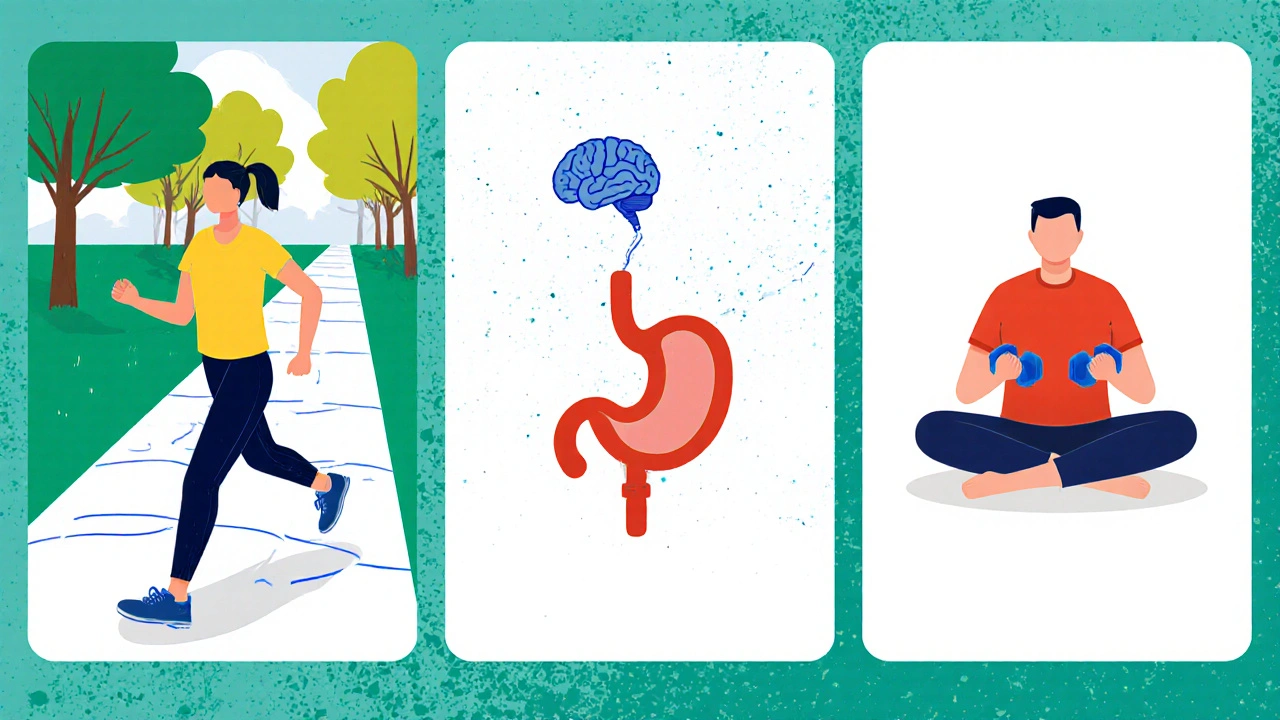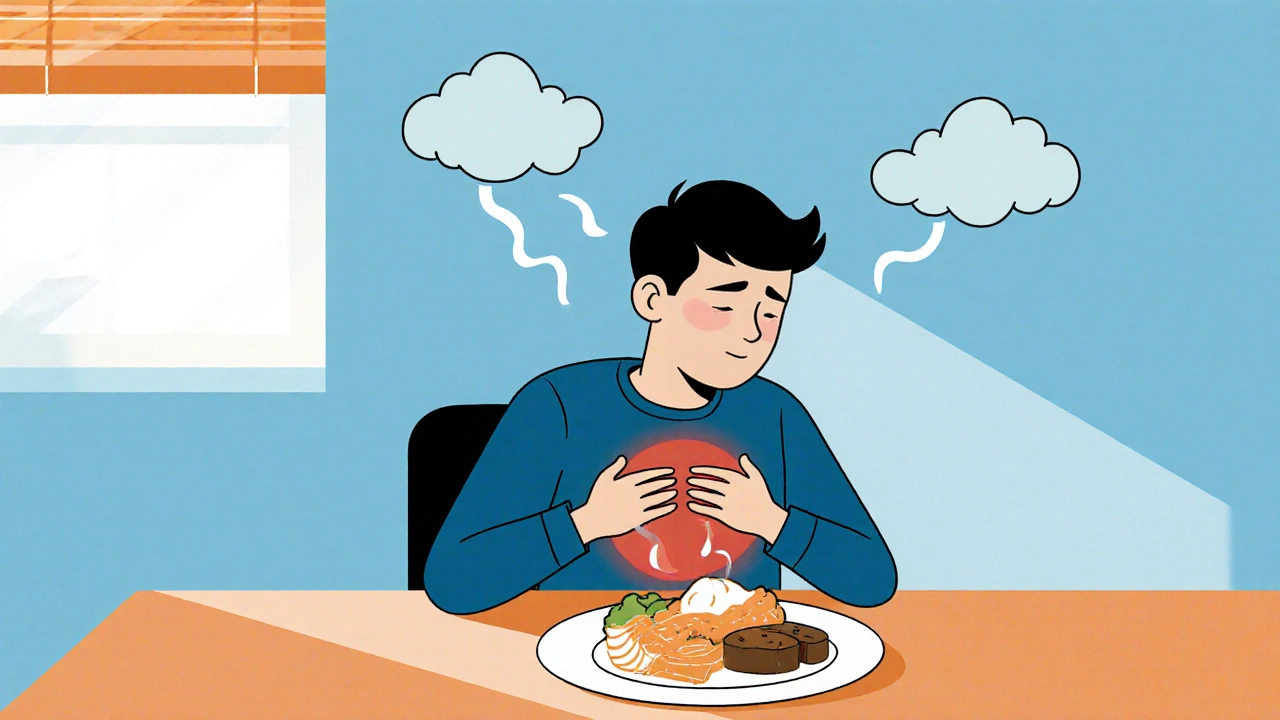Living with functional dyspepsia can feel like a nonstop battle with uncomfortable fullness, bloating, and burning sensations after meals. While medications and diet tweaks are common, many people overlook a surprisingly powerful ally: regular movement. This article breaks down why and how exercise can ease those nagging symptoms, what types of activity work best, and how to build a safe, effective routine.
What Is Functional Dyspepsia?
Functional Dyspepsia is a chronic disorder of the upper gastrointestinal tract characterized by persistent upper‑abdominal pain, early satiety, and post‑prandial fullness without an identifiable structural cause. It affects roughly 10‑15% of adults worldwide and is diagnosed after other organic diseases (like ulcers or cancer) have been ruled out. The condition is often linked to abnormal gastric motility, heightened visceral sensitivity, and an imbalanced gut‑brain communication pathway.
How Exercise Influences the Gut
When you move, you’re not just burning calories - you’re sending signals through the Gut‑Brain Axis, a two‑way communication system that connects the central nervous system with the enteric nervous system. Physical activity stimulates vagal tone, reduces systemic inflammation, and can normalize the rhythmic contractions that propel food through the stomach and small intestine (known as gastric motility). In simple terms, exercise helps the stomach empty more efficiently, which directly tackles two of the biggest complaints of functional dyspepsia: bloating and early fullness.
Exercise Types That Benefit Functional Dyspepsia
Not all workouts are created equal when it comes to gut health. Here’s a quick rundown of the three categories that research shows to be most helpful.
- Aerobic Exercise involves rhythmic, moderate‑intensity activities that increase heart rate and breathing. Walking, jogging, cycling, and swimming fall into this group and have been shown to improve gastric emptying by up to 20% after a 12‑week program.
- Resistance Training focuses on muscle strengthening using weights, bands, or body‑weight movements. Studies suggest that moderate‑intensity resistance work (2-3 sessions per week) can boost abdominal wall tone, which indirectly supports better stomach positioning and reduces reflux‑type discomfort.
- Yoga and Stretching incorporate gentle poses, breath work, and relaxation techniques. Specific asanas-like seated forward bend and supine twists-help lengthen the gastrointestinal tract, promote parasympathetic activation, and lower perceived stress, a known trigger for dyspeptic flare‑ups.

Designing a Safe and Effective Routine
Starting slow is key. Below is a practical template you can adapt based on fitness level and symptom severity.
- Frequency: Aim for 4-5 days per week of mixed activity.
- Intensity: Keep aerobic sessions in the “talk test” zone (moderate intensity, ~50‑70% of max heart rate). For resistance work, use light‑to‑moderate loads (12‑15 reps, 2‑3 sets).
- Duration: Begin with 10‑15 minutes of walking after meals, gradually building to 30‑45 minutes spread across the day.
- Timing: A 20‑minute walk 30‑60 minutes post‑meal is often the sweet spot-helps move food along without over‑stimulating the stomach.
- Progression: Add a short interval of jogging or cycling after two weeks, then introduce a light resistance circuit (e.g., body‑weight squats, wall push‑ups) after four weeks.
Combining Exercise with Gut‑Friendly Lifestyle Tweaks
Exercise shines brightest when paired with complementary habits.
- Fiber Intake: Soluble fiber (oats, psyllium) improves gastric emptying, while insoluble fiber (whole grains, nuts) can worsen bloating if over‑consumed. Aim for 25‑30 g daily, split between meals.
- Probiotic Support: Strains such as Lactobacillus plantarum and Bifidobacterium infantis have modest evidence for reducing dyspeptic pain. A daily probiotic capsule or fermented foods can be a good adjunct.
- Stress Management: Mind‑body practices-deep breathing, meditation, or progressive muscle relaxation-lower cortisol, which in turn reduces gut hypersensitivity.
- Meal Timing: Smaller, more frequent meals (4-5 per day) and avoiding lying down for at least two hours after eating help keep gastric pressure low.
Common Pitfalls and How to Avoid Them
Even well‑intentioned exercise plans can backfire if you ignore a few warning signs.
- Over‑exertion: High‑intensity interval training (HIIT) may spike adrenaline, worsening abdominal pain. Reserve HIIT for days when symptoms are minimal.
- Exercise on a Full Stomach: Running or heavy lifting right after a large meal can increase intra‑abdominal pressure and trigger reflux. Stick to low‑impact walks during peak digestion.
- Inadequate Hydration: Dehydration slows gastric motility. Sip water throughout the day, but avoid large gulps immediately before or during intense cardio.
- Neglecting Rest: Rest days allow the gut to adapt. Skipping them can lead to chronic fatigue and worsen dyspeptic symptoms.
When to Seek Professional Help
If you notice any of the following, it’s time to talk to a healthcare provider:
- Unintentional weight loss >5% of body weight.
- Persistent vomiting or difficulty swallowing.
- Bleeding signs (black stools, vomiting blood).
- Symptoms that do not improve after 8‑12 weeks of lifestyle changes.
A physician may recommend tests like an upper endoscopy, gastric emptying study, or H. pylori screening to rule out other conditions.
Quick Action Checklist
- Walk 15‑20 minutes after each main meal.
- Include 2 resistance sessions per week (body‑weight or light weights).
- Practice a calming yoga pose routine 3‑4 times weekly.
- Track fiber intake; aim for 25‑30 g daily.
- Start a daily probiotic or add fermented foods.
- Monitor symptom diary; adjust intensity if pain spikes.
Frequently Asked Questions
Can I do high‑intensity workouts if I have functional dyspepsia?
High‑intensity sessions can increase abdominal pressure and trigger symptoms. It’s better to start with moderate aerobic activity and only add brief intervals once you’re symptom‑free for several weeks.
How long before I should see improvement?
Most studies report noticeable reduction in bloating and fullness after 6‑8 weeks of consistent exercise combined with dietary tweaks.
Is yoga really effective for dyspepsia?
Yes. Specific asanas stimulate the vagus nerve and promote gentle abdominal massage, which can speed up gastric emptying and lower stress‑related pain.
Should I fast before exercising?
A light snack (e.g., a banana) 30‑60 minutes before moderate activity is fine. Full fasting may lead to low blood sugar and worsen abdominal discomfort.
Can a probiotic replace exercise?
Probiotics can help balance gut flora, but they don’t address the motility issues that exercise improves. Use both for best results.

6 Comments
Xavier LuskyOctober 21, 2025 AT 15:29
They don't want you to know that the pharma lobby is pushing pills while ignoring simple movement. Exercise is a cheap tool that keeps you off their profit charts. The whole “gut‑brain axis” thing sounds like a buzzword to sell overpriced supplements. Stay skeptical and keep walking after meals; it's better than being a pawn.
Ashok KumarNovember 2, 2025 AT 08:53
The article gets the basics right, but seriously, who has time for a 45‑minute jog after every bite? Just a brisk 10‑minute walk does the trick, no need for a marathon.
Esther OlabisiNovember 14, 2025 AT 02:50
Love the vibe! 🚶♀️💪 Even a short stroll can kick that bloated feeling to the curb. Keep sharing these tips, they’re gold! 😎
Ivan LaneyNovember 25, 2025 AT 20:46
Let me lay it out for the uninitiated: our great nation thrives on movement, and that includes your gut. The moment you sit still after a meal, you’re basically sabotaging the American dream of a healthy digestive tract. Aerobic exercise, like jogging or cycling, isn’t just a hobby; it’s a patriotic duty to keep your stomach emptying efficiently. Resistance training, with its emphasis on core strength, reinforces proper posture, preventing the dreaded reflux that plagues the lazy. Yoga, with its deep breathing, taps into the vagus nerve, which, incidentally, is a key player in the gut‑brain axis-something the mainstream media would love to keep hidden. By ignoring these simple strategies, you’re feeding into a global elite that profits from chronic discomfort. Think about it: a 15‑minute walk after dinner can reduce bloating by up to 20%, according to reputable studies that aren’t censored. That’s a statistic the government doesn’t want you to know because it undermines pharmaceutical sales. Hydration is critical; sip water, but don’t gulp it like a frat boy during a workout. Rest days are not a sign of weakness; they’re a strategic pause to let the gut adapt, much like how a nation needs time to recover after conflict. Over‑exertion, like HIIT on a full stomach, spikes adrenaline, which can exacerbate pain-so keep high‑intensity sessions for symptom‑free days. The bottom line: consistent, moderate movement is your best defense against functional dyspepsia, and it costs nothing, unlike the endless stream of prescription pills. So lace up those shoes, stand tall, and march forward-your gut, and your country, will thank you.
John PriceDecember 7, 2025 AT 14:43
Walking after meals is a simple win.
Jake HayesDecember 19, 2025 AT 08:40
This so‑called “balanced routine” is just a repackaged list of obvious advice. If you can’t manage a 10‑minute walk, you’re not going to benefit from any of this.